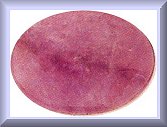


|
Amethyst is one of a variety of stones that fall under the general classification of Quartz (Silicon Dioxide.) While pink colored Quartz is usually called “Rose Quartz,” the purple Quartz is Amethyst.
The purple color comes from impurities of iron and/or manganese. Black Amethyst Glass, a highly collectible glass still being made today, but very popular during the Art Deco period, is generally made by adding minerals including iron, manganese, gold and cobalt to the molten silica. One of the most beautiful configurations of natural Amethysts comes when the crystals grow within a geode, rather like a rough egg on the outside, while hollow and crystalline on the inside. Some of these can be quite large, ranging up to six feet or more in height, and are often referred to as “Cathedrals.”
Exposure to direct sunlight can cause Amethysts to fade from deep purple to a pale lavender over a period of time. Exposure to high temperatures will typically change the purple color to brown or yellow. A number of Citrines started their lives as Amethysts until they were exposed to heat treatments. Some Amethysts, particularly those from some Brazilian mines, turn green when subjected to such heat treatment, though this is relatively rare.
The stone’s name comes from a legend concerning the God, Bacchus, who became angry with the Goddess, Diana. Unable to harm Diana directly, Bacchus, in a wine-induced rage, vowed to slay the next human he met by having them eaten alive by tigers. The next person to cross his path was a beautiful young woman, named Amethyst. When Bacchus set his tigers on her, she cried out to Diana for protection. Diana, protectress of all wild things, did not want to slay the tigers, so she did the next best thing. She turned
Amethyst into a hard, clear stone, which the tigers could not harm. Bacchus, when sober, rued his hasty act, and was filled with remorse. He offered a libation of his favorite wine to the young woman, pouring the liquid over the stone, which absorbed the color, and became permanently purple. Interestingly, the word “Amethyst” means “not intoxicated” in Classical Greek (“a-“ meaning “not,” and “methystein” meaning “to become intoxicated.”) This puts an interesting spin on the old myth.
Contemporary research reveals that Magickal practitioners have treasured the powers of the Amethyst for well over 3,000 years, and perhaps much longer than that! For centuries, Amethyst has been considered “the Healer’s Stone.” Because of the fact that religious leaders have been expected to have the power to heal by the “laying on of hands,” the Amethyst is generally set in the rings worn by Roman Catholic Bishops, including the Bishop of Rome, the Pope.
Amethyst has long been believed to prevent intoxication, and is especially useful in helping people recover from substance abuse. Its calming nature is frequently beneficial to ease the suffering associated with withdrawal from alcohol, tobacco or other harmful addictive and/or mind-altering drugs.
Spiritually, Amethyst helps to balance conflicting emotions, while stimulating the qualities of compassion, empathy and tolerance. Couples frequently wear matching Amethyst jewelry (rings, pendants, etc.), to help bring their spirits into harmonious balance. This is especially useful when the couple are both strong individuals, with sometimes clashing, or competitive, personalities. It is a stone which helps attract love, but strangely enough, this ability seems to work best when worn by men, rather than women. It is also noted for its abilities in healing traumas to the nervous system and brain.
Amethyst is an extremely spiritual stone, helping one communicate with the Higher Self as well as helping to form a link to the Divine. It is especially useful in helping one to achieve one’s highest goals and objectives, and in helping to see beyond immediate desires to the highest good. It is excellent for helping one to stay grounded, and helps strengthen the “Silver Cord” which links the spirit to the body during Astral Travel.
As the primary crystal linked to the Crown Chakra, the seat of psychic gifts, it also helps one develop one’s talent as a channel, or medium. Because of its use in bolstering one’s psychic awareness, those who practice the arts of divination frequently keep Amethysts with their Tarot decks, Rune stones, etc. Pendulums made of Amethyst are particularly useful in helping to find lost objects, but the stone’s inherent desire to please often causes a pendulum to be unwilling to give less than pleasant answers to questions. |